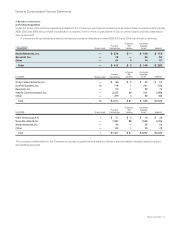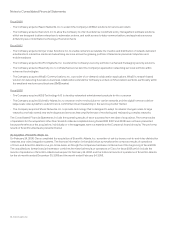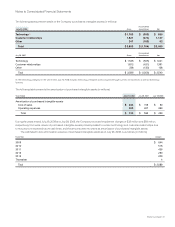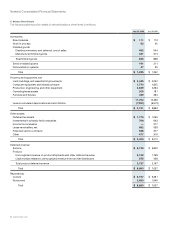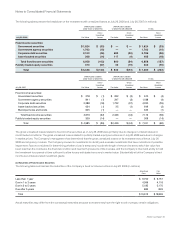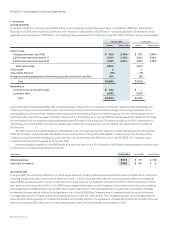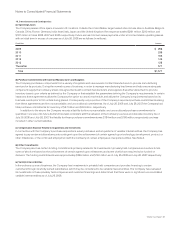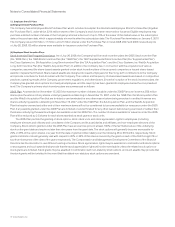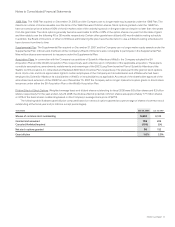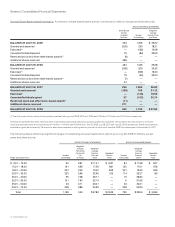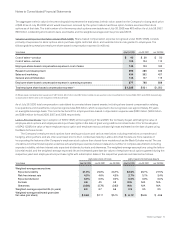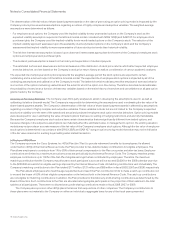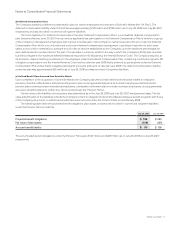Cisco 2008 Annual Report Download - page 62
Download and view the complete annual report
Please find page 62 of the 2008 Cisco annual report below. You can navigate through the pages in the report by either clicking on the pages listed below, or by using the keyword search tool below to find specific information within the annual report.
2008 Annual Report 67
Notes to Consolidated Financial Statements
9. Derivative Instruments
The Company uses derivative instruments primarily to manage exposures to foreign currency, interest rate, and equity security price risks.
The Company’s primary objective in holding derivatives is to reduce the volatility of earnings and cash flows associated with changes
in foreign currency, interest rates, and equity security prices. The Company’s derivatives expose it to credit risk to the extent that the
counterparties may be unable to meet the terms of the agreement. The Company seeks to mitigate such risks by limiting its counterparties
to major financial institutions. In addition, the potential risk of loss with any one counterparty resulting from this type of credit risk is
monitored. Management does not expect material losses as a result of defaults by counterparties.
(a) Foreign Currency Derivatives
The Company’s foreign exchange forward and option contracts are summarized as follows (in millions):
July 26, 2008 July 28, 2007
Notional
Amount Fair Value
Notional
Amount Fair Value
Forward contracts:
Purchased $ 1,803 $ 5 $ 1,601 $ 1
Sold $ 902 $ 2 $ 613 $ (8)
Option contracts:
Purchased $ 1,440 $ 50 $ 652 $ 24
Sold $ 1,256 $ (6) $ 310 $ (1)
The Company conducts business globally in numerous currencies. As such, it is exposed to adverse movements in foreign currency
exchange rates. To limit the exposure related to foreign currency changes, the Company enters into foreign currency contracts. The
Company does not enter into foreign exchange forward or option contracts for trading purposes.
The Company enters into foreign exchange forward contracts to reduce the short-term effects of foreign currency fluctuations on
assets and liabilities such as foreign currency receivables, including long-term customer financings, investments, and payables. Gains
and losses on the contracts are included in other income (loss), net, and offset foreign exchange gains and losses from the revaluation of
intercompany balances or other current assets, investments, or liabilities denominated in currencies other than the functional currency
of the reporting entity. The Company’s foreign exchange forward contracts related to current assets and liabilities generally range from
one to three months in original maturity. Additionally, the Company has entered into foreign exchange forward contracts with maturities of
up to two years related to long-term customer financings. The foreign exchange forward contracts related to investments generally have
maturities of less than two years. The Company also hedges certain net investments in its foreign subsidiaries with forward contracts which
generally have maturities of less than six months.
The Company hedges certain foreign currency forecasted transactions related to certain operating expenses with currency
options and forward contracts. These currency option and forward contracts generally have maturities of less than 18 months and these
transactions are designated as cash flow hedges. The effective portion of the derivative’s gain or loss is initially reported as a component
of accumulated other comprehensive income and subsequently reclassified into earnings when the hedged exposure affects earnings.
The ineffective portion, if any, of the gain or loss is reported in earnings immediately. During fiscal 2008, 2007, and 2006, there were no
significant gains or losses recognized in earnings for hedge ineffectiveness. The Company did not discontinue any hedges during any
of the years presented because it was probable that the original forecasted transactions would not occur.


